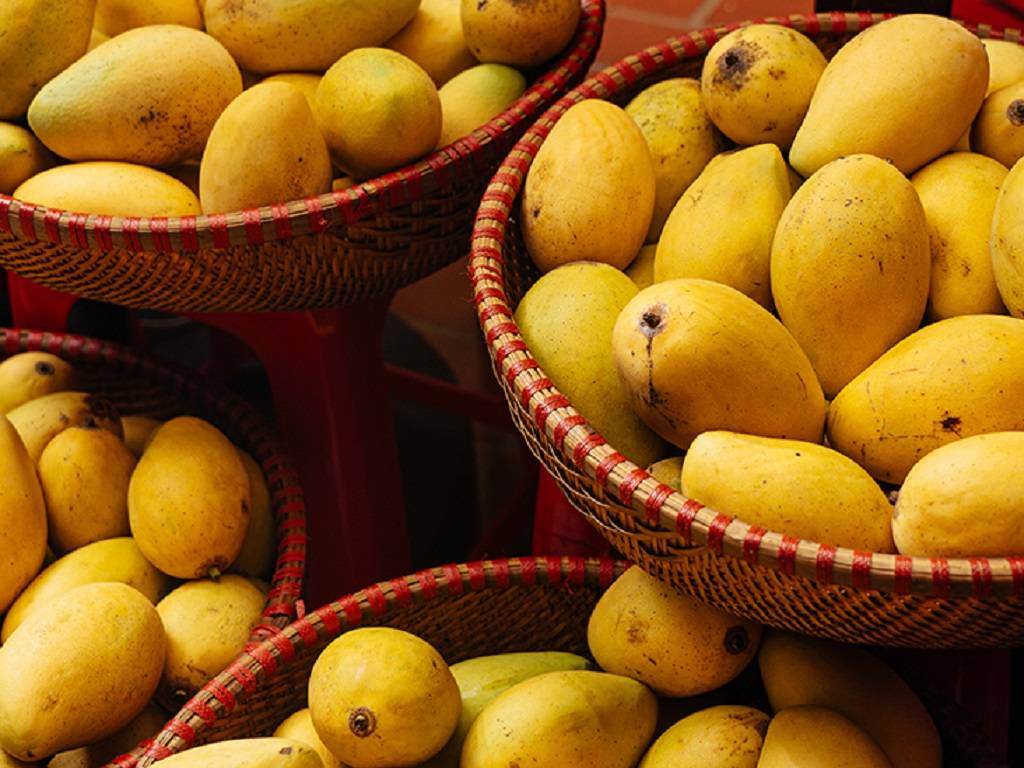
Do you LOVE mangoes but don't know how to pick a good one? Here is a perfect guide for you. We will tell you the Do’s and Don’ts while selecting mangoes and things which should strictly be avoided. You will also be informed about the method to identify season-wise TOP 10 popular varieties of Mangoes in India.
How to choose a perfect mango?
Some Do’s & Don'ts while purchasing mangos:
-
While buying mango, don’t focus on color. There are many different varieties of mangos. Their color varies, for example, some go from green to red, some end up Orange, and some start off yellow and end up orange. Therefore, color is not the best indicator of ripeness. Don’t judge a mango by its color.
-
A ripe mango is likely to smell sweet. They will sometimes have a fruity aroma on their stems. You must check near the stem end, the smell should be stronger there.
-
Squeeze the mango gently. A ripe mango will squeeze easily as it will become softer.
-
Mangos will soften as they ripen just like peaches. When it starts going from firm to soft, it is just about ripe.
-
As we all know that a ripe fruit will be slightly heavier than an unripe one. Therefore, if you feel that the mango is heavier then be careful, it is an indication of its ripeness.
-
Always avoid mangoes that are too hard as it will take a long time for them to rip.
-
If you find some black spots on the skin of the Mango then it indicates that the fruit is already ripened. Whereas, the wrinkled appearance of Mango indicates that the fruit has been harvested too early and may not be sweet.
-
Don’t choose the mangoes that have a sour or alcoholic smell.
-
Leave the mangoes cool at room temperature till their flesh is yielding.

Top 10 Popular Varieties of Mangoes in India & Simple Way to Identify Them:
India holds around 56% of the world’s mango production, having more than 1000 varieties. The popularity of mangoes varies in each region. It depends on the manner in which they are used or eaten.
Different Varieties of Mangoes in India:
1. Safeda/ Banganapalli
Season – Starts from April to June
It is known as one of the earliest varieties of mangoes to come in the market. It is originally from Andhra Pradesh and has achieved widespread acceptance across the country. The skin has a lovely bright yellow hue and the taste is slightly sour. These mangoes are quite fibreless.
2. Pairi
Season – Begins in May & June
The skin’s reddish tinge of Pairi mango variety is a dead giveaway. They are not sickly sweet but have a noticeable sour bite hidden. It is used to make aamras in Gujarat if Kesar is not available. Take care that their keeping quality is not that good so consume them quickly post-purchase.
3. Neelam
Season – From May to July
It can easily be noticed with its distinctive lovely fragrance. It is available throughout the season but the tastiest ones come in only by June with the monsoons. Interestingly, these varieties are a favorite in Hyderabad, though they are produced all over the country. They are also tiny in comparison to other varieties and have an orange skin color.
4. Alphonso/ Hapus
Season – Starts in May to June
Small spherical and ‘king of mangoes’ we are talking about none other than Alphonso mangoes. It originated in Maharashtra and is also grown in Gujarat and parts of Karnataka and Madhya Pradesh. Do you know that it is perhaps the most expensive variety of Indian mangoes? Well yes, they are and are exported in plenty of numbers.
5. Himsagar
Season – May
Himsagar has the shortest-lived season as compared to others. These mangos are most popular among Bengalis. They are fiber-less and fleshy and are a great choice for milkshakes.
6. Dussehri
Season – From June to July
Popularly called ‘chusne wala aam’ by kids, this mango is best enjoyed by mostly everyone. Originated in Uttar Pradesh, they are one of the oldest mango varieties in the country.
7. Totapuri
Season – June to July
You can easily identify these mangos by their shape with the tip looking like a parrot’s beak. Their homeland is Karnataka, Andhra Pradesh, Telangana, and Tamil Nadu. Though, it is not as sweet as the other mangos but is great for salads or with a tempering of salt and chilies. Interestingly, it is used as an ingredient for many mass-produced mango products in India.
8. Kesar
Season – June to Early July
It has the most distinguishing fragrance and feature, the color of the pulp resembles saffron. The skin is greener than most other mangoes. They are grown in and around Ahmedabad, and Gujarat, these are used primarily to make aamras in Gujarat.
9. Chausa
Season – Starts from July to August
Chausa comes in the market at a time when you think the mango season is coming to an end. They are popular in North India and Bihar and have incredibly sweet pulp and bright yellow skin. The best of them come from Pakistan and are exported across the world.
10. Langra
Season – Mid July to August
This fibrous mango variety is very much popular in West Bengal, Haryana, Uttar Pradesh, and Bihar.
Hope this article will be helpful for all the Mango Lovers! We will appreciate your comments and queries in our comment box below. Do let us know what more information you need. Pick your favorite choice of mangos now and enjoy the mango season.
















